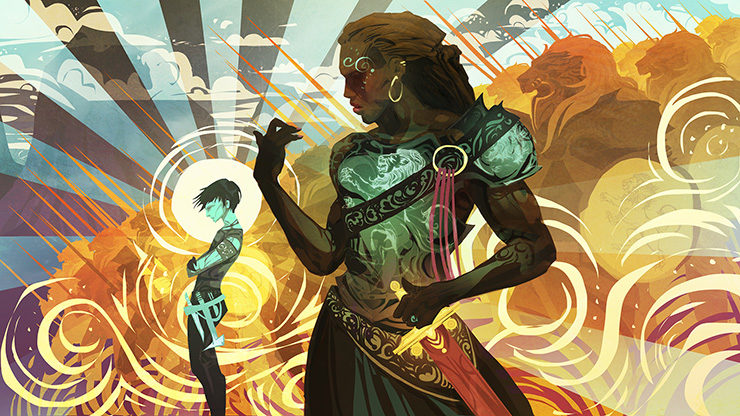“As a kid I cut my drawing teeth on fabulous winged beasts, magical weaponry and figures in outlandish costumes,” said Hugo Award-winning artist Galen Dara, whose clients include 47 North, Fantasy Flight Games, and Fireside Magazine. “The fantastical was always my wheelhouse. As a reader I value speculative fiction’s ability to be both delightful escapism and searing social commentary.”
Watching Dara’s career blossom has been one of the most delightful benefits of being a part of the SFF fan community over the past several years. She first gained popularity as a fan artist, producing vivid SFF art unlike anything else. In 2013, Dara won the Hugo Award for “Best Fan Artist.” Since then, she’s been nominated for several other high profile awards, including a couple more Hugos, the Chesleys, and the World Fantasy Award (which she won in 2016). Except now she’s competing among professionals instead of fans. It’s safe to say that Dara’s arrived.
“My path [to get here] meandered quite a bit,” Dara said when I asked for the story of how she went from fan artist to professional. “Throughout grade school I excelled in art related courses so naturally when I went to college it was to get an art degree. But I wasn’t ready for college, and didn’t have a clear idea of what I wanted. So, after a few semesters I dropped out, got a job, and just took classes part time from the local community college, mostly painting and lifedrawing.”
Of course, that wasn’t the end for Dara, only another beginning. After dropping out of college, she traveled “a bit,” always with a sketchbook. Finally, she returned to college, this time working on a BFA in Illustration.
“Halfway through, one of the Fine Art instructors turned my head to a more esoteric direction, so that by the end of my BFA I was doing things like hanging stuff from the ceiling to create environments that you could walk into, or wrapping broken egg shells in translucent paper and dangling them from strings on the wall. After my degree I was in a few fine art shows, but only sporadically.”
Dara’s burgeoning career slowed down when her son was born, after which she “wasn’t able to do much more than keep a sketchbook and dabble in photography.”
As she settled into parenthood, however, it dawned on her that she could use photoshop and other digital tools to clean up her sketches. She started posting those revised sketches online. “Then I began using photoshop to add colors and textures to my sketches,” she explained. Though she completed her BFA in Illustration, she had to teach herself how to integrate these digital tools into her workflow. From there, she developed her technique and adapted her style to have a stronger digital foundation. “A friend gave me a used wacom tablet,” she remembers, “which I used for touch-ups. Eventually I began to draw and paint directly in Photoshop.
“By that time, I was already getting a steady stream of small illustration jobs, and I used those to teach myself new things. Eventually I attended a week long immersion course where I got feedback from speculative fiction artists like of Rebecca Guay, Dan Dos Santos, Brom, Scott M. Fischer, Greg Manchess, and Iain Mccaig. That was incredible. I still occasionally visit workshops for instruction and feedback.”
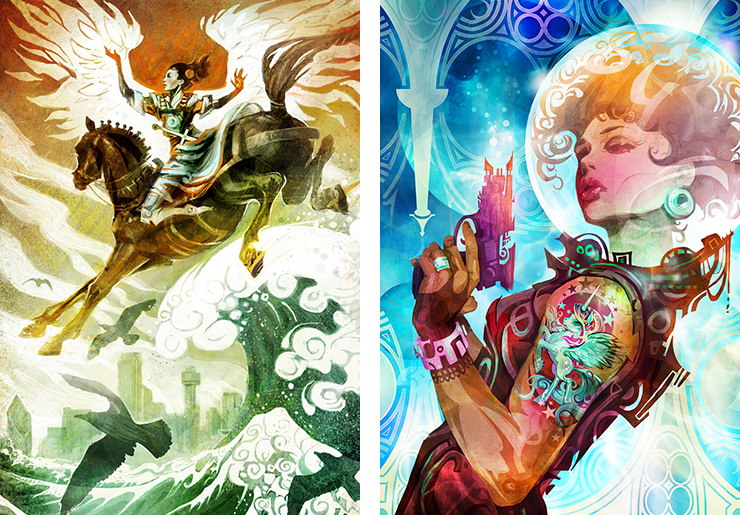
Similar to Richard Anderson, who I profiled in in an earlier post, Dara produces art that is raw and impressionistic, trading glossiness and strict definition for nerve-tingling emotion. It’s impossible to ignore her striking style. Whether on the cover of Lightspeed or Uncanny Magazine, you recognize her art right away. Bold and daring, whispered promises, and imagery that sticks with you like a vivid dream.
“It’s possible the roundabout way I got here contributes to my style. My path as an artist was not a straight trajectory, so I come at problems from a non-traditional angle, with a varied backstory informing my decisions. In some cases my path has left gaps in my education that I have to find creative ways to compensate for. My favorite artists tend towards graphic boldness: I love the work of Scott Bakal, Goni Montes, Jillian Tamaki, Joao Ruas, Jeffrey Alan Love, Victo Ngai, James Jean, Yoshitaka Amano, Anna and Elena Balbusso.”
One of the side effects of the “graphic boldness” of Dara’s influence, is that she’s become a strong visual storyteller. One of my favorite aspects of her work is that it feels complete, but, thanks to her impressionistic style, also compels you to keep thinking about the circumstances behind the scene it’s portraying. Part of that is due to her process, which involves a lot of instinct, a variety of tools, and open communication with her clients.
Covers are a collaborative effort, Dara admits. So where does one begin when interpreting another artist’s work?
“With short stories I typically pick the visual inspiration out from my reading of the story. For something longer, like the cover of a novel, I get an art brief that gives me a basic rundown of the setting, characters, and the feel of the book. For game card art, I get a brief that lays out the direction of the card. Other than those differences, my process for all projects starts the same: collecting all sorts of applicable imagery and making a bunch of mood boards. I’ll grab images from pop culture, graphic design, art history, fashion, architectural, nature. Sometimes I’ll make a mood board just laying out how other artists have tackled similar concepts. Often I’ll make mood boards just with color schemes.
“Then I’ll move onto collages: cutting and pasting shapes and imagery, taking stuff apart, putting it back together in different arrangements. Doing this digitally allows me a lot of flexibility to reshape the collage quickly and create lots of variations: I can resize elements, flip them, shift things around, alter the values, draw in additional elements, redraw the stuff that doesn’t quite fit. It’s about finding the sweet spot that make me happy. (I’ll frequently zoom the image out to thumbnail size on my computer screen to get the overall at-a-glance impact of the piece.) This is usually done in greyscale. Once the client and I are happy with the preliminary composition, I start turning it into a full color painting. I use a lot of low opacity glazes and a lot of masks/stencils.”
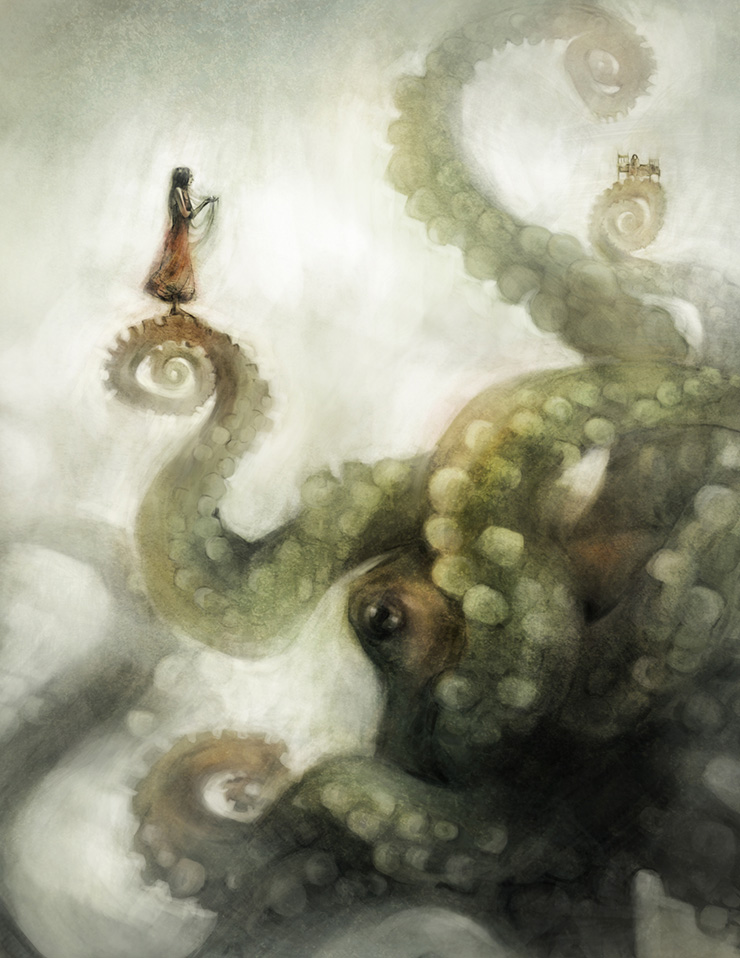
A digital canvas offers limitless opportunities for experimentation, but Dara finds that, just like an artist who has a favorite paintbrush or pen, she often goes back to her most tried-and-true tools. “While I have hundreds of brushes in my Photoshop toolbox, I always come back to two or three of them: high texture brushes that I use both to lay down color and to scratch it back out again.
“Frequently I’ll need to alter the overall composition as I go; things that I thought worked great initially end up not working once the painting is in full swing. Stuff needs to be added or taken out or altered. There’s a lot of push and pull in this phase as I re-discover what the sweet spot is again and again. Always there’s a point where I wonder if I’ll be able to pull it off, be able to make the painting turn out successfully. It’s nerve-wracking.”
In fact, it’s not all fun and games, even for an artist who has appeared on several high-profile award ballots. As any creative professional knows, clients often have specific requests, and a different idea of what a final product should look like than the artist.
“I’m fortunate that many of my clients provide me with a fair amount of freedom to explore things ‘my way.’ But it’s tricky—just recently I had an experience where the distance between my style and what the client wanted was too wide. That was hard and it’s natural to second guess myself.
“Being an artist means being able to take rejection, learn from it, keep on going.”
That dedication to her profession has earned Dara many fans within both fandom and the publishing industry, including Michael Damien Thomas, co-founder of Uncanny Magazine. “Galen Dara is simply one of the best cover artists working in our corner of the field today,” he told me. “Her art is vibrant and alive. Her compositions sing with color and movement. Dynamic and striking, a Galen Dara cover grabs your eye and plunges you into one of her fantastical worlds. We have used Galen as a cover artist on our magazines and anthologies numerous times, and are so proud that she made our first Uncanny Magazine Cover. Plus, she is a joy to work with.”
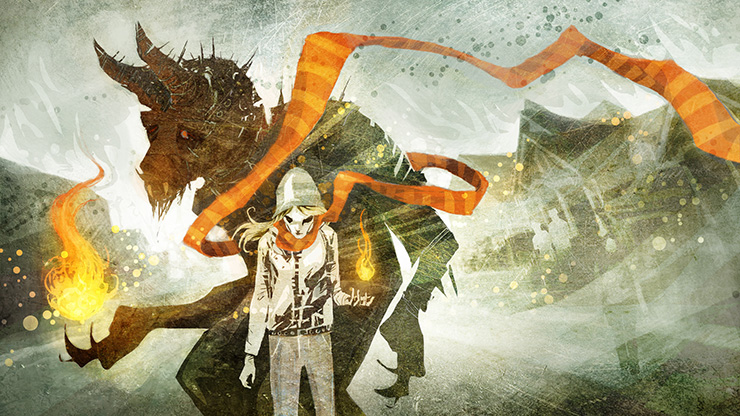
Dara’s already worked with some heavyweight, but which author would she most like to collaborate with? “Kij Johnson,” she answered. “I read her short story “Spar” years ago when I was just getting back into making art. It blew my mind and inspired multiple sketchbook pages full of disturbing imagery. I really love her mind.”
(“Spar” is, erm… boldly NSFW. Make sure your boss and/or little children aren’t around when you start reading it.)
Dara demurred when I asked if she’d share those sketches.
“I’m not sure I could find them now, and as I recall they are definitely not work appropriate! Anyways, what I scratch out in my sketchbooks nowadays rarely has much relation to the art I’m creating for clients: it’s purely a way for me to process stuff, a sort of brain dump, raw and messy and random. Helps keep me sane, but it’s not always pretty.”
Drawn to speculative fiction by its “endless possibilities,” Dara sees a bright future for SFF powered by artists and fans of all stripes. “The best way for me to answer this,” she said when I asked her where she sees SFF cover art going over the next five years, “would be to say who I’d love to see creating SFF cover art in the coming years: I’d love to a SFF art world full of artists of color, queer and transgender artists, women, etc. These creators are already out there, but to see their work become more visible in the top tiers of the SFF publishing industry would be a very satisfactory thing.”
By its nature, speculative fiction eschews boundaries and explores humanity’s infinite complexities. It shouldn’t be held back societal and cultural -isms (racism, sexism, etc.), but often is. As Dara points out, the creators are there, but how can SFF—artists, fans, and the gatekeepers in the publishing industry—continue to create more opportunities for artists of marginalized backgrounds?
“This is THE question, right? How to overcome the challenges that certain populations face when trying to gaining access to opportunities?
“I wish I had a good answer. One thing that occurs to me is that I want people to become more aware of the artist behind the artwork. It may seem like a silly thing, but whenever various art awards are announced, I immediately scan the lists for names of women. I get a thrill when I see them represented.
“When Julie Dillon won the 2014 Hugo Award for “Best Professional Artist” it was the first time in history that had ever happened. Women hadn’t even been on the ballot for decades—and now a “woman has won that award for the past three years. Three years later, there are four women nominated for Best Professional Artist, outnumbering the men on the ballot two to one. There are problematic aspects to gauging progress by awards, but it’s such a visible thing it can’t be discounted.
“Awards such as the Hugo are prestigious, but represent only a small part of the vast community of SFF fans. Dara recognizes that while it’s important to see women, artists of color, and LGBTQ artists recognized at such a level, change also has to come from the industry’s grassroots. “More practical than awards is the day to day visibility of art in the industry—whenever I pick up a novel to check out the cover art, or a comic book, or a magazine, or game card, first thing I do is check who did the illustrations. Like award lists, I get a little buzz when I find out the artist who created that amazing illustration was a women. Since names are often gendered, that’s a pretty easy filter. It may take a little more research to expand that awareness to find artists of color, or who are LGTBQ, etc.
“A few years ago Lightspeed Magazine did a series of {___} DESTROY {___} special issues dedicated to this; “Women Destroy Science Fiction,” “Queers Destroy Science Fiction,” “People of Colo(u)r Destroy Science Fiction” (Nightmare and Fantasy Magazine did likewise). Those were great issues dedicated to creators of that particular group. But, it’s complicated because there are many artists who don’t like being labeled in that way. They want their art to speak for itself, and not have their gender or race or sexual identity be what calls attention to it. So while highlighting and cheerleading artists from a particular background is all well and good, it’s still an imperfect solution to a very complex problem.”
The future of SFF is undetermined, but with artists like Galen Dara leading the way—and opening doors for all dreamers, artists, and fans—we can rest assured that it’s in good hands.
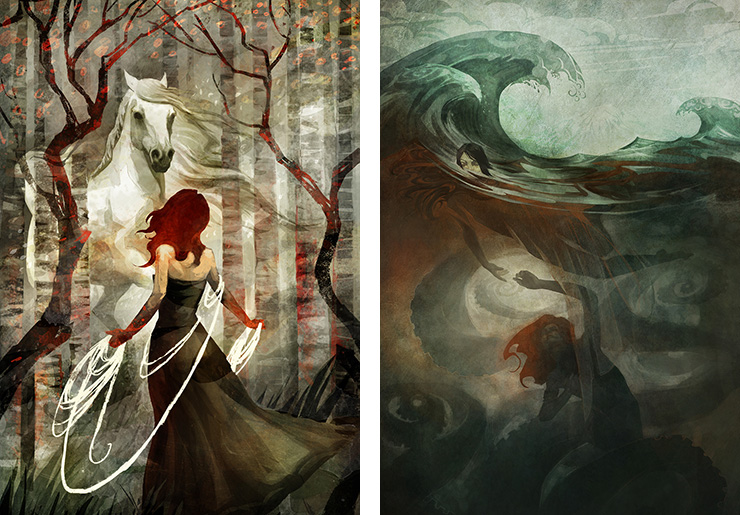
You can find more of Galen Dara’s art on her website, or follow her on Instagram, Facebook, and Twitter.
Originally published in June 2017.
Aidan Moher is the Hugo Award-winning founder of A Dribble of Ink, author of Tide of Shadows and Other Stories and “The Penelope Qingdom”, and regular contributor to Tor.com and the Barnes & Noble SF&F Blog. Aidan lives on Vancouver Island with his wife and daughter, but you can most easily find him on Twitter @adribbleofink.










